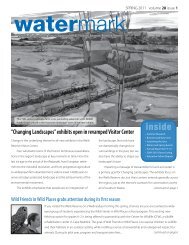Management Plan - National Estuarine Research Reserve System
Management Plan - National Estuarine Research Reserve System
Management Plan - National Estuarine Research Reserve System
You also want an ePaper? Increase the reach of your titles
YUMPU automatically turns print PDFs into web optimized ePapers that Google loves.
NERR system recently implemented a standardized,nationwide program using the GeostationaryOperational Environmental Satellites (GOES)system, a critical component of the IntegratedOcean Observing <strong>System</strong> (IOOS). The data aretransmitted via satellite at 15 minute intervals,and are used by <strong>National</strong> Weather Service’sHydrometeorological Automated Data <strong>System</strong>, andcan be viewed online by anyone. The <strong>Reserve</strong> willcontinue to support telemetry and other efforts thatintegrate with the Gulf of Maine Ocean Observing<strong>System</strong> and IOOS. More generally, the <strong>Reserve</strong>will promote awareness of SWMP data within theGulf of Maine scientific community.Figure X.3. A long night of field work is just beginning.Photo by Andrea Leonard.Data Committee. The CDMO then compiles anddisseminates all system-wide data and summarystatistics over the world-wide web, where researchers,coastal managers, and educators may readilyaccess the information.Telemetry, or the delivery of data to remote users inreal-time or near real-time, is an important elementof SWMP. Although telemetry efforts have beenongoing at Wells NERR for over six years, theWells <strong>Reserve</strong> <strong>Research</strong> Themes<strong>Estuarine</strong> Water QualityWater quality is monitored continuously at severalstations with automated instruments as part ofthe <strong>System</strong> Wide Monitoring Program, as wellas bimonthly at 15 to 20 stations through theWatershed Evaluation Team (WET) volunteermonitoring program. These data have allowed usto identify several bacterial “hot spots,” are used toidentify and open areas safe for shellfishing, andhave uncovered a relation between tides and lowdissolved oxygen levels. Our water quality work hascontributed to the designation of several “PriorityWatersheds” in coastal southern Maine by theMaine Department of Environmental Protection.Our water quality data is currently being used aspart of a NOAA Northeast regional assessmentof estuarine eutrophication. Our partnershipwith Maine Sea Grant and the University of NewHampshire has identified species-specific sources ofbacterial contamination in our coastal watersheds.Salt Marsh Habitats andCommunitiesFactors that control the dynamics and vigor of saltmarsh plant communities and marsh peat formationdetermine the ability of a salt marsh to persistin the face of sea level rise. Through a combinationof experimental manipulations and long termmonitoring, we are producing data to answer ques-82 Wells <strong>National</strong> <strong>Estuarine</strong> <strong>Research</strong> <strong>Reserve</strong>




